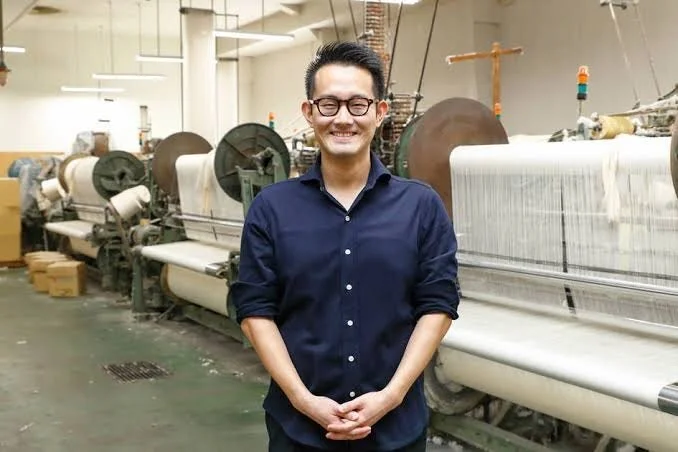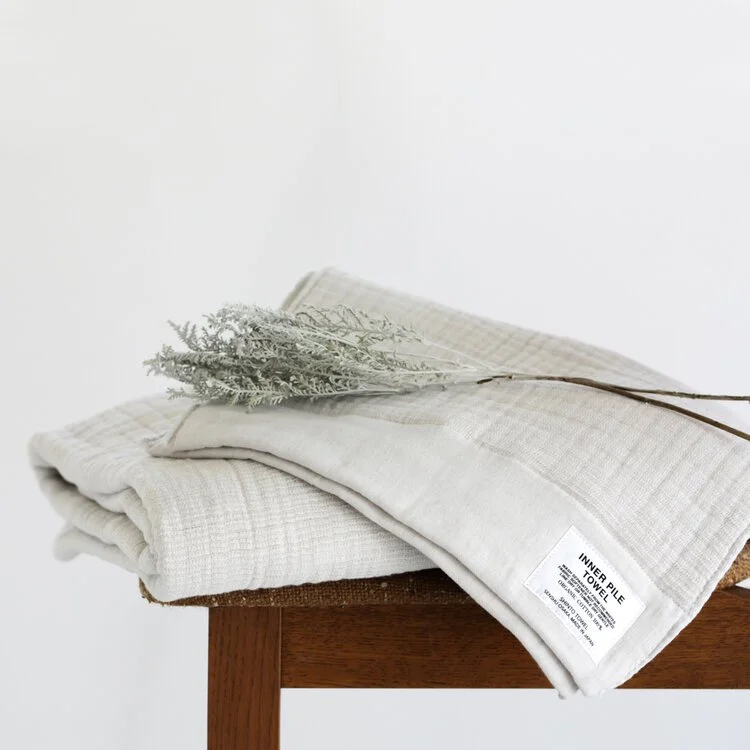A Look Inside Shinto’s Generational Quest to Create the Perfect Towel
Most people only think about their towels when stepping out of the shower.
For Takashi Shinto, they’re a reason to get up in the morning.
This scion of the Shinto family honors the history of the company his great-great-grandfather founded while casting an eye toward the future.
Learn more about one of the most popular lines at rikumo in our interview with the owner of Shinto Towel.
For those unfamiliar with your company, Shinto Towel, can you give us a brief introduction?
We are a towel manufacturer located in Izumisano-shi, a countryside city in Osaka, where the Japanese towel manufacturing industry was created in 1887.
Our company has been manufacturing high-quality towels since 1907, and we built upon our century-long history of craftsmanship and refinement to create our new factory brand, SHINTO TOWEL, in 2017. Since then, we’ve made it our mission to answer the question, “What makes the perfect towel?”
I was born in Osaka in 1986. My father was not involved in the family business, so I grew up in Tokyo where my father worked as a banker. I had never lived in Osaka or even stepped foot in my grandfather’s company until I graduated from university and decided to enter the family business.
I was an outsider with no knowledge of towel manufacturing, but with a lot of research, support, and training from senior employees, I am now running the company. Thanks to my unique background, I look at my company and the traditional towel industry of the Senshu region with the objective eye of an outsider. Correcting the bad and improving the good, loving my work but still thinking like an outsider is necessary to contribute to both the company and the regional towel manufacturing industry.
How did the Shinto family get its start in the towel business?
When towels came to Japan from Europe, they were rare and quite expensive, and people used them primarily as mufflers or stoles. At that time, Japanese people used plain-weave cotton fabric (tenugui) instead of towels.
Eventually, a man named Enjiro Satoi in Izumisano invented terry weaving in Japan by analyzing the structure of the imported towels. He realized that terry fabric absorbs more water than tenugui. After his invention, these towels became very popular, and towels became one of the region’s biggest industries.
While it was still just a cottage industry, my great-great-grandfather gathered two of his friends and decided to set up a factory in 1907. This is how SHINTO TOWEL was started, and today it is one of the oldest towel manufacturers in Izumisano.
What does a typical day involve for you?
I mainly work in the office, replying to emails and orders I receive from retailers or doing research on the Internet. In the morning, my first task is to check the delivery schedule for the days ahead to ensure things are moving on time. Then I go through every department to greet everyone and see how they are doing before going back to my office to work.
When my staff is especially busy, I will sometimes pack and transport towels to and from our subcontractors. My primary responsibility is to think about the direction of the company, but I can do that at the same time as packing and transporting the product. After all of the staff leaves, I work on the machinery or do leftover office work.
What do you think sets your towels apart from those of other manufacturers?
We have two original gauze towels that feature unique structures that didn’t exist until our company invented them. I’d say the originality and uniqueness of our towels’ structures and textures would be two of our trademark characteristics.
Also, we use some very old machines that are maintained by the special care of our experts. Our Inner Pile series is made exclusively on these old machines. So maintenance by experts and the effective use of older machines for special products might be aspects as well.
What is meant by the term atozarashi? What does this process do?
Atozarashi is a traditional refining process in our region. To describe it most simply, it’s a very large-scale laundering.
Cotton contains natural wax, starch, and other impurities that prevent the fibers from absorbing water. During atozarashi, we remove the impurities in the threads to increase strength, absorbency, and durability.
“Ato” means “after” and “zarashi” (or “sarashi”) means the refining process, so atozarashi implies that we do the refining after weaving the towel. This means that the refining process comes at the end of the whole towel manufacturing process so that the impurities will be washed away just before towels are delivered to customers’ hands.
From where do you source your cotton? Is it important to use organic cotton?
The cotton for the Shinto Towel brand is organic cotton from India, but historically the production area is not very important to us; we chose by balancing quality and price. But, considering the global environment and our aim to create the best towels, we thought it should also be necessary to become more eco-friendly.
What are some current trends you see in the towel industry?
When talking about the Japanese towel market, the trend is toward soft, fluffy, and thick designs. Also, gauze towels are becoming very popular due to their lightweight and quick-drying nature. In Japan, the minimalist way of thinking is growing, so towels are also becoming more minimal in design. As for color and size, charcoal grey is trendy, and people are starting to move away from large bath towels in favor of smaller sizes.
Many people are familiar with Imabari towels. How does the industry in Osaka compare?
Imabari has a very famous regional towel industry, but the scale of the production there is nearly the same as in our region. The main difference is that they do their refining and dyeing before weaving (a process called sakizarashi) so that they can use many colors with jacquard machines to express various designs. But the absorbency is often higher with atozarashi, so I think there is variety in terms of functionality and design for the customers.
What is the most challenging aspect of running your business?
It is true that we need some special knowledge and skill to use and fix our looms, and not so many young people are working in our industry, but the most challenging aspect is that our production can’t be fully completed on our own.
Towel manufacturing in Japan is mostly divided into sections (weaving, dyeing, refining, sewing, printing, and so on), and each section is outsourced to specialized subcontractors. It is quite difficult to operate the whole production process on our own.
This means that we have to keep the production at a certain level to allow each subcontractor to keep on working; otherwise, we would be unable to produce the end products. We have to think not only about our own company but also about supporting the whole regional industry at the same time.
What advice would you give to someone who is shopping for a towel?
Please take the time to compare and select from the towels in the shop and try as many types of towels as you can by confirming the feel and absorbency. You might think it’s just a towel, but it should make you feel unexpectedly happy and comfortable when you use the perfect one.
Do you have a personal favorite Shinto towel?
My personal favorite is the Yukine series. Yukine is very special due to its extraordinary absorbency, so from the aspect of functionality, it most represents the benefits of our traditional atozarashi method. I think this is our best answer to how a towel should be.
What would you like to say to someone who uses your towels?
It would be so great if one of our towels would become your new favorite, hopefully forever!






